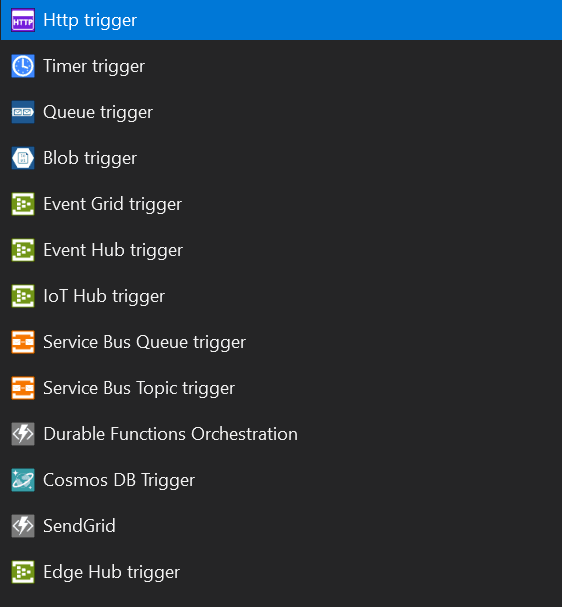Hey! This article comes from my blog, code4it. Check it out for more content!
Azure Functions are event-driven applications that run serverless. Usually, they are triggered by an HTTP request, an update on Blob storage, a message on Service Bus, or simply a timer.

You can build Azure Functions with different languages, such as C#, Java, JavaScript and so on. One of the features that made the success of Azure Functions is the pricing: you pay only for the time spent running your code.
If you want to know more about Azure Functions, you can refer to the official Microsoft documentation.
When you create an Azure Function (version 2) following the Visual Studio wizard, the example code that you get is something like this:
public static class AzureFunctionV2
{
[FunctionName("SayHello")]
public static async Task<IActionResult> Run(
[HttpTrigger(AuthorizationLevel.Anonymous, "get", "post", Route = null)] HttpRequest req,
ILogger log)
{
log.LogInformation("C# HTTP trigger function processed a request.");
string name = req.Query["name"];
string requestBody = await new StreamReader(req.Body).ReadToEndAsync();
dynamic data = JsonConvert.DeserializeObject(requestBody);
name = name ?? data?.name;
return name != null
? (ActionResult)new OkObjectResult($"Hello, {name}")
: new BadRequestObjectResult("Please pass a name on the query string or in the request body");
}
}
The first thing to notice is that this is a static class. So you can't use a constructor, so... bye-bye, Dependency Injection!
How can you implement it?
Before moving on, a plot twist!
Azure Functions can also be non-static
Even though the wizard marks both the class and the function as static, they can also be used as non-static.
So, this function is equally valid:
public class AzureFunctionV2
{
[FunctionName("SayHello")]
public async Task<IActionResult> Run(
[HttpTrigger(AuthorizationLevel.Anonymous, "get", "post", Route = null)] HttpRequest req,
ILogger log)
{
// do something
}
}
Now you can add a constructor and inject your dependencies on it. I've created a simple service that just says hi.
public interface IGreetingsService
{
string SayHi(string name);
}
public class GreetingsService : IGreetingsService
{
public string SayHi(string name)
{
return $"Hi, {name}! Pleased to meet you!";
}
}
So now you can inject IGreetingsService into the constructor of you Azure Function and use it within your method (you'll notice I've done some refactoring in the Run method):
public class AzureFunctionV2
{
private readonly IGreetingsService _greetingsService;
public AzureFunctionV2(IGreetingsService greetingsService)
{
this._greetingsService = greetingsService;
}
[FunctionName("SayHello")]
public async Task<IActionResult> Run(
[HttpTrigger(AuthorizationLevel.Anonymous, "get", "post", Route = null)] HttpRequest req,
ILogger log)
{
string name = req.Query["name"];
return !string.IsNullOrWhiteSpace(name)
? (ActionResult)new OkObjectResult( _greetingsService.SayHi(name) )
: new BadRequestObjectResult("Please pass a name on the query string or in the request body");
}
}
Everything works fine!
No, just joking! 😅
If we try it at http://localhost:7071/api/SayHello?name=davide, we get this error:
Microsoft.Extensions.DependencyInjection.Abstractions: Unable to resolve service for type 'AzureFunctionV2Example.IGreetingsService' while attempting to activate 'AzureFunctionV2Example.AzureFunctionV2'.
Obviously, this happens because we haven't defined that when we are injecting an IGreetingsService we want to use the GreetingsService concrete class. If you have already worked with .NET Core, you surely know that the dependencies are defined in the Startup class; but now that class is missing.
We can create it from scratch, but we must specify that this class implements Microsoft.Azure.WebJobs.Hosting.IWebJobsStartup. The Intellisense prompts us that we must implement the interface, so we'll get this empty class:
using Microsoft.Azure.WebJobs;
using Microsoft.Azure.WebJobs.Hosting;
namespace AzureFunctionV2Example
{
public class Startup : IWebJobsStartup
{
public void Configure(IWebJobsBuilder builder)
{
throw new System.NotImplementedException();
}
}
}
By adding a reference to Microsoft.Extensions.DependencyInjection.Extensions we can define the dependencies within the Configure method:
public void Configure(IWebJobsBuilder builder)
{
builder.Services.TryAddScoped<IGreetingsService, GreetingsService>();
// OR
builder.Services.TryAddScoped(typeof(IGreetingsService), typeof(GreetingsService));
}
As you might imagine, we can have Scoped, Transient and Singleton dependencies.
Now we have created also the Startup class; unluckily, it's not enough: we must declare that the whole assembly must look at this Startup class to find the Startup class to use. For typical .NET Core application, this is done automatically for us; here we must declare it explicitly.
We can do that by adding the attribute [assembly: WebJobsStartup(typeof(Startup))] to the namespace.
+ [assembly: WebJobsStartup(typeof(Startup))]
namespace AzureFunctionV2Example
{
Wrapping up
We have seen how to define Dependency Injection in Azure Functions. We've done it by following a few steps:
- Create the Startup class and implement the
IWebJobsStartupinterface - Add an attribute that specifies which class must be used as the Startup class for this assembly
- Transform the Azure function to make it non-static
- Inject the dependency in the constructor.
These few steps allow us to do great things, like reading values from the config file and inject them with an IOptions<T> class. Also, now we can test the Azure Functions by mocking the dependencies.
You can read a different point of view on this topic in this article on Medium.
Also, if you want to learn even more, you can refer to the Microsoft documentation. Pay attention that this is updated to Azure Functions v3 instead of v2.
Finally, you can see a working example on my GitHub repository.
Happy coding!
PS: in the next article I'll explain how to migrate from v2 to v3: this also implies a small change to the Startup class. Stay tuned!




Top comments (1)
What does Ilogger Log does ?